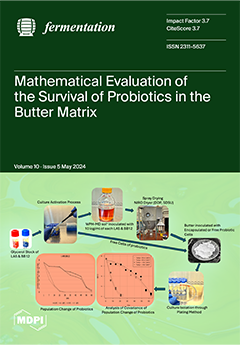The biotechnology of converting methane to single-cell protein (SCP) implies using fast-growing thermotolerant aerobic methanotrophic bacteria. Among the latter, members of the genus
Methylococcus received significant research attention and are used in operating commercial plants.
Methylococcus capsulatus MIR is a recently discovered member
[...] Read more.
The biotechnology of converting methane to single-cell protein (SCP) implies using fast-growing thermotolerant aerobic methanotrophic bacteria. Among the latter, members of the genus
Methylococcus received significant research attention and are used in operating commercial plants.
Methylococcus capsulatus MIR is a recently discovered member of this genus with the potential to be used for the purpose of SCP production. Like other
Methylococcus species, this bacterium stores carbon and energy in the form of glycogen, particularly when grown under nitrogen-limiting conditions. The genome of strain MIR encodes two glycogen synthases, GlgA1 and GlgA2, which are only moderately related to each other. To obtain glycogen-free cell biomass of this methanotroph, glycogen synthase mutants, Δ
glgA1, Δ
glgA2, and Δ
glgA1Δ
glgA2, were constructed. The mutant lacking both glycogen synthases exhibited a glycogen-deficient phenotype, whereas the intracellular glycogen content was not reduced in strains defective in either GlgA1 or GlgA2, thus suggesting functional redundancy of these enzymes. Inactivation of the
glk gene encoding glucokinase also resulted in a sharp decrease in glycogen content and accumulation of free glucose in cells. Wild-type strain MIR and the mutant strain Δ
glgA1Δ
glgA2 were also grown in a bioreactor operated in batch and continuous modes. Cell biomass of Δ
glgA1Δ
glgA2 mutant obtained during batch cultivation displayed high protein content (71% of dry cell weight (DCW) compared to 54% DCW in wild-type strain) as well as a strong reduction in glycogen content (10.8 mg/g DCW compared to 187.5 mg/g DCW in wild-type strain). The difference in protein and glycogen contents in biomass of these strains produced during continuous cultivation was less pronounced, yet biomass characteristics relevant to SCP production were slightly better for Δ
glgA1Δ
glgA2 mutant. Genome analysis revealed the presence of
glgA1-like genes in all methanotrophs of the
Gammaproteobacteria and
Verrucomicrobia, while only a very few methanotrophic representatives of the
Alphaproteobacteria possessed these determinants of glycogen biosynthesis. The
glgA2-like genes were present only in genomes of gammaproteobacterial methanotrophs with predominantly halo- and thermotolerant phenotypes. The role of glycogen in terms of energy reserve is discussed.
Full article





